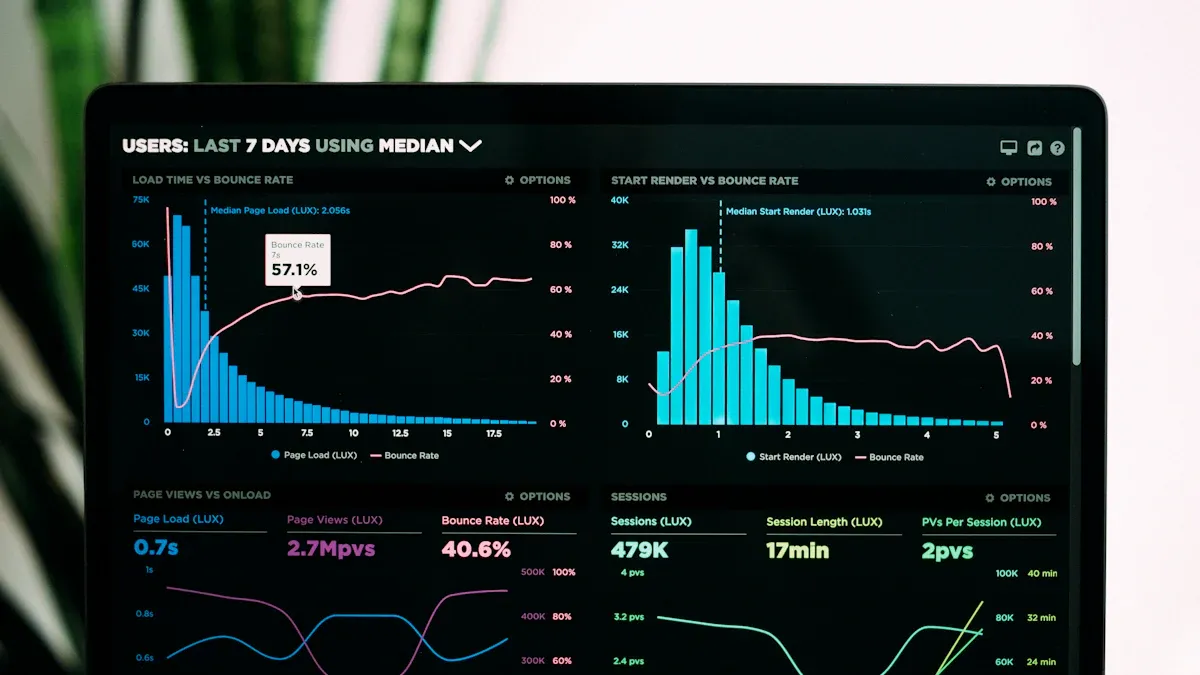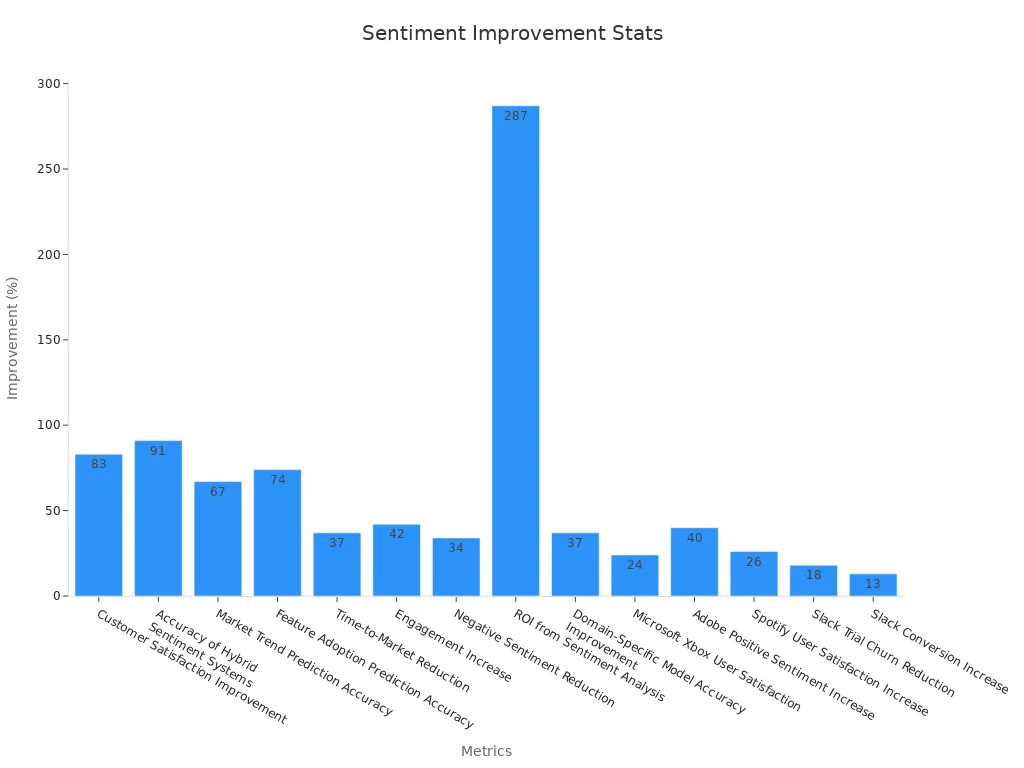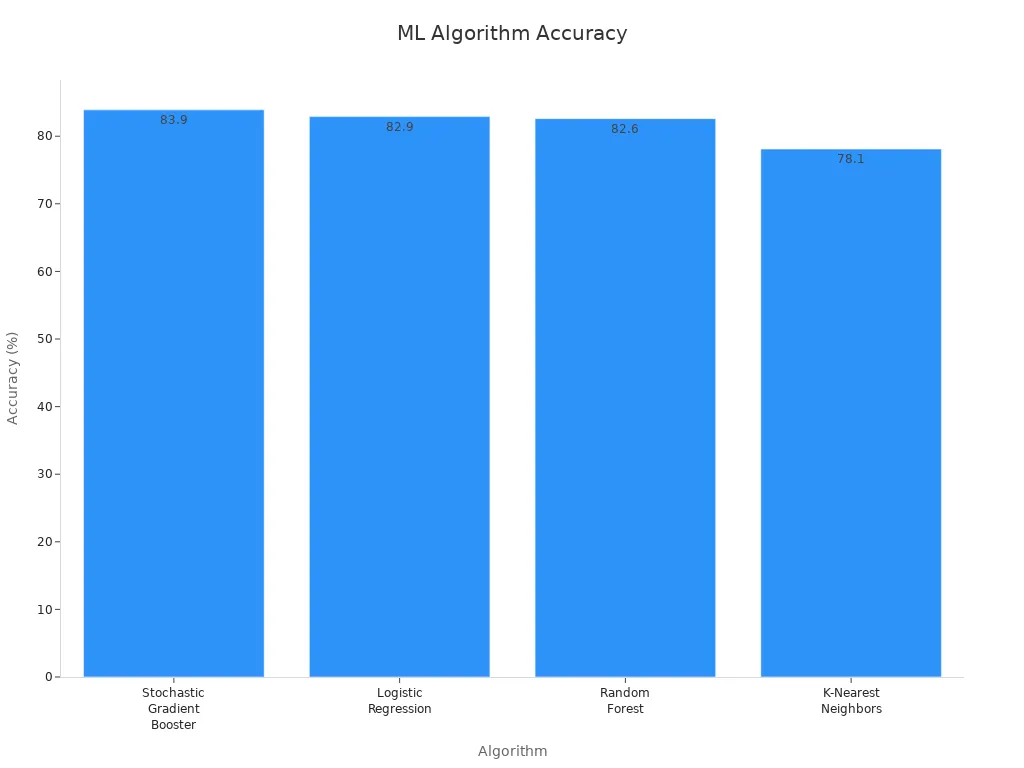Customer Feedback Analysis using AI Tools for Real-Time Insights

Businesses today must respond fast to what customers want. Many leaders wonder, “How can a company know what customers feel and act right away?” AI tools help by giving real-time insights from Customer Feedback Analysis.
77% of companies now try generative AI, and 35% use it every day.
Almost 80% of customers say they have good experiences with AI-driven support.
A recent example shows T-Mobile used real-time AI sentiment analysis to lower client complaints by 73%. This change helps companies stay ahead and meet customer needs faster than before.
Key Takeaways
AI tools look at customer feedback right away. This helps businesses find problems and trends fast. They can make products and services better. These tools take feedback from many places like social media, emails, and surveys. This gives a full view of how customers feel. AI-powered alerts tell teams about big problems quickly. Teams can fix issues faster and make customers happier. Using AI means less manual work and more accuracy. It is easy to use as businesses get bigger. This saves time and money. Clear goals, team training, and checking often help companies use AI feedback analysis well. This builds customer trust.
AI for Real-Time Insights

Instant Data Processing
AI tools can look at customer feedback right away. They check emails, chats, surveys, and social media as soon as they come in. Companies do not need to wait a long time for reports. Now, they know what customers think almost instantly. This helps teams find problems early and fix them fast.
AI feedback tools watch customer comments all day and night.
Sentiment analysis finds good or bad feelings right away.
Topic categorization puts feedback into groups like bugs or design issues.
Trend detection spots patterns early so teams can act quickly.
Custom filters help staff see the most important feedback.
Multilingual support lets global companies get results in every language.
Note: Real-time data processing helps businesses react fast after a product update. They can see how customers feel and make changes right away.
New AI systems also cut down on manual work. Automated reports save time and make things more accurate. Real-time feedback loops help teams keep making products and services better. These tools lower mistakes and help people make decisions faster.
Automated Trend Detection
AI does more than just look at data fast. It also finds trends that people might not see. Automated trend detection uses smart models to track changes in customer feedback over time. This helps companies find new problems or chances before they get big.
AI tools like Chattermill, Usabilla, Qualtrics, and Wonderflow check feedback from many places at once.
Sentiment analysis can be up to 91% accurate with hybrid systems.
Trend detection helps guess market changes and if people will use new features.
Real-time dashboards show changes in customer mood, cutting bad feelings by 34% in six months.
Here is a table that shows how AI makes sentiment analysis and trend detection better:
Metric / Insight | Statistic | Description |
|---|---|---|
Customer Satisfaction Improvement | 83% | Companies see big gains in one year with AI sentiment analysis |
Accuracy of Hybrid Sentiment Systems | Up to 91% | Hybrid AI models do better than single-method ones by 17% |
Market Trend Prediction Accuracy | 67% | Multi-source sentiment analysis makes market trend predictions better |
Feature Adoption Prediction Accuracy | 74% | Early sentiment analysis predicts feature adoption with this accuracy |
Negative Sentiment Reduction | 34% | Real-time dashboards cut negative feelings in six months |

Automated trend detection gives companies a clear idea of what customers want. Teams can use these insights to make products better, make customers happier, and stay ahead of others.
Actionable Alerts
AI-powered systems do more than just look at data. They also send alerts when something important happens. These alerts help teams act fast and stop problems from getting worse. For example, if lots of people complain about a new feature, the system sends a warning right away.
AI communication tools help stop delays and missed follow-ups.
Fast, personal messages across channels make customers happier.
Automation cuts mistakes and lets staff do more important work.
AI insights help with better pricing and inventory choices.
Scalable systems handle more feedback without needing more workers.
A business consultancy used AI alerts to get more sales. A 1% rise in meetings booked brought in $30 million more in sales. Better sales conversion rates added another $60 million. AI alerts also help sales teams spot deals that might fail. Automated notifications let managers help before deals are lost, so win rates and forecasts get better.
Tip: Actionable alerts from AI systems help companies act faster, keep customers happy, and grow their money.
Customer Feedback Analysis gets much stronger with instant processing, trend detection, and actionable alerts. These features help businesses make better choices and keep customers happy in real time.
Customer Feedback Analysis with AI

Machine Learning and NLP
Machine learning and natural language processing (NLP) are very important for modern Customer Feedback Analysis. These tools help companies know what customers say and feel right away. Machine learning models, like decision trees and neural networks, can look at lots of feedback fast. NLP tools read and understand words from reviews, emails, and social media.
Machine learning lets sentiment analysis find out how customers feel from text.
Predictive analytics uses machine learning to guess what customers might do next, like if they will leave.
Personalization gets better as AI gives special tips based on each person’s feedback.
Automation does simple jobs, like sorting tickets, so work gets done faster.
Real-time choices are possible because data is always being checked.
Machine learning models get smarter as they see more new data.
A study of machine learning algorithms shows these models work better with tricky and hard-to-understand customer data than old ways. They spot patterns and guess what people might do, like buy something or stop using a service. As these models get more feedback, they become more correct, so they are very good for Customer Feedback Analysis.
Algorithm | Accuracy (%) |
|---|---|
Stochastic Gradient Booster | |
Logistic Regression | 82.9 |
Random Forest | 82.6 |
K-Nearest Neighbors | 78.1 |
These numbers show that machine learning is strong at guessing what customers will do. Companies can use these tools to get good answers.

Old math methods, like logistic regression, are still helpful because they are simple and easy to understand. But machine learning can do more and work with bigger, harder data. Sometimes machine learning is hard to explain, but it gets better with more data, so it is a great pick for Customer Feedback Analysis.
Note: Machine learning and NLP help companies find hidden patterns and fix small problems before they get big.
Types of Feedback Data
Customer Feedback Analysis uses many kinds of data. Each kind shows a different side of what customers think and feel. Companies get feedback from surveys, product reviews, support tickets, emails, and social media.
Structured data has ratings, survey scores, and yes/no questions. AI tools can use this data easily.
Unstructured data is open comments, chat logs, and social media posts. NLP tools help understand these words.
Audio and video feedback comes from calls or video reviews. AI can write down and study these.
Behavioral data shows how customers use products or services. This helps guess what they might do next.
A good Customer Feedback Analysis system uses all these types of data together. This way, companies see the whole picture of how customers feel. For example, survey scores might look good, but social media posts could show hidden problems.
Tip: Using both structured and unstructured data gives better ideas and helps make smarter business choices.
Multi-Channel Analysis
Customers share their thoughts in many places. Multi-channel analysis means looking at feedback from all these places at the same time. This makes sure no important comment is missed.
Social media, like Twitter and Facebook, gives feedback right away.
Email and chat logs show common problems and what customers need.
Online reviews on Google and Yelp show what is good or bad about a product.
In-app feedback and surveys tell how users feel while using the app.
AI tools can collect and check feedback from all these channels. Seeing everything together helps companies spot problems and act fast. For example, if people complain about a new feature on social media and in support tickets, the company can fix it quickly.
Multi-channel analysis also helps companies see how feedback changes in different places or cultures. Global companies like AI tools that work with many languages and types of data.
Callout: Multi-channel Customer Feedback Analysis helps companies stay close to their customers, no matter where or how they share their ideas.
Benefits of AI Tools
Speed and Accuracy
AI tools work very fast with customer feedback. They can check thousands of reviews in just a few hours. One company looked at over 10,000 reviews in less than one day. If people did this by hand, it would take weeks. Teams can find problems and trends almost right away. AI uses smart data rules to be more correct. These systems make fewer mistakes than people. One business changed its packaging after using AI insights. Bad reviews about packaging went down by half. Customer happiness scores went up by 10%. AI tools check feedback up to ten times faster than old ways. This speed and accuracy help companies make good choices quickly.
Scalability
AI tools grow with the business. When feedback gets bigger, AI can still handle it. Teams do not need to hire more people to read comments. AI can check thousands of comments every day. The table below shows how AI is better than doing it by hand:
Aspect | Traditional Manual Analysis | AI Feedback Analysis |
|---|---|---|
Speed of Insight | Insights delayed by days or weeks | Real-time or instant analysis across all channels |
Scalability | Effort grows with volume; requires more people | Effortless handling of thousands of responses daily |
Accuracy & Consistency | Subjective tagging varies by person or team | Consistent application of tagging logic every time |
AI tools help companies keep up with feedback as they get bigger.
Actionable Insights
AI tools do more than just gather data. They turn feedback into easy-to-use ideas. Teams get alerts when something important happens. Managers see patterns and trends as they come up. This real-time info helps companies answer customer needs fast. With AI, Customer Feedback Analysis becomes a strong way to make products and services better. Companies can use these ideas quickly, so customers are happier and business gets stronger.
Implementing AI Analysis
Data Collection
Good Customer Feedback Analysis starts with strong data collection. AI feedback tools gather info from many places. These places include surveys, support tickets, CRM systems, and social reviews. Tools like Anecdote AI connect to over 125 data sources. This makes it simple to put all feedback in one spot. Multi-channel survey sharing helps every customer get heard. Teams should collect both structured and unstructured data for a full view.
Tool Selection
Picking the right AI tool helps feedback analysis work well. Top platforms have features like AI survey creation, sentiment and theme detection, multilingual support, and real-time reports. Some tools, like Zonka Feedback and Qualtrics, give predictive insights, emotion detection, and dashboards for different jobs. Advanced tools also offer entity mapping, workflow automation, and anomaly detection. Teams should pick tools that fit their business needs and skills.
Integration
Integration links AI feedback tools with daily business tasks. Many tools work with CRM, helpdesk, and project management apps like Slack, Jira, and Trello. For example, SentiSum and Zonka Feedback let teams route tickets and work together. This smooth integration sends feedback right into team workflows. It helps teams act on insights fast. Central feedback spots help everyone stay updated and on the same page.
Monitoring
Ongoing monitoring makes sure AI analysis stays helpful and reliable. Teams watch metrics like task completion, response quality, efficiency, and system reliability. Regular checks help find problems like hallucinations or bad data. Groups also check if people are happy and if rules are followed. By using dashboards and performance tools, teams can change their plans as tech and business needs shift.
Tip: Standard processes and teamwork make AI-driven feedback analysis more accurate and trustworthy.
Real-World Impact
Retail
Retail stores have changed a lot with AI feedback analysis. Companies like Amazon and Stitch Fix use AI to suggest products for each shopper. This made Amazon’s sales go up by 25%. Customer satisfaction at Amazon also went up by 30%. Stitch Fix saw more people buy clothes, with a 20% higher conversion rate. Their customers were 30% happier with AI clothing picks. Sephora uses AI chatbots to help shoppers find what they want. This makes people shop more and stay loyal.
A study in Vietnam showed AI tools really help online shopping. People liked using AI and bought more things. Stores use AI to guess what items they need to order. This stops them from running out or having too much, by up to 30%. AI also helps stores send special deals to shoppers. These deals make people spend 15% more and come back 20% more often.
AI tools let stores help shoppers faster, make shopping better, and earn more money.
SaaS
SaaS companies use AI to check customer feedback and grow their business. Netflix uses AI to pick shows and ads for each person. This brings in new users and keeps old ones watching. AI can help SaaS companies keep more customers, lowering churn by 25%. AI onboarding programs help people stay and buy more.
Financial Metric | Description | Example / Application |
|---|---|---|
Revenue Growth | Sales increase from customer feedback actions | Higher sales after onboarding improvements |
Cost Savings | Lower costs from automation | Streamlined support reduces overhead |
ROI | Profit compared to investment | Positive ROI from AI-driven customer success programs |
A SaaS company spent $100,000 on an AI onboarding program. After five years, they made $82,323 more than they spent. This shows AI feedback analysis is worth the money.
Hospitality
Hotels and spas use AI to make guests happier and work better. Bella Santé used AI to answer 75% of customer questions. This brought in $66,000 more in sales. Eye-oo made customers wait less, cutting wait times by 86%. Their sales went up by 25%. ADT used AI support tools to make guests 30% happier. Their conversion rates went from 44% to 61%.
Faster replies make guests happier.
AI feedback analysis helps staff fix problems quickly.
Personalized tips help guests book more and come back.
AI helps hotels make every guest feel special, get better reviews, and earn more money.
Challenges and Solutions
Data Privacy
Data privacy is a big worry for companies using AI in Customer Feedback Analysis. Many people are scared about how their data is collected and kept safe. Reports say 68% of people around the world worry about their online privacy. Also, 57% think AI is a real danger to their privacy. Another study says 75% of people are scared about AI risks. More than half say AI makes it harder to keep their personal info safe. People feel mixed about trust. Some trust businesses with AI, but 70% of Americans do not trust companies to use AI the right way.
To fix these worries, companies should have clear rules for collecting data. They need to store data safely and ask customers before using it. Data anonymization and regular security checks help keep private info safe. Teams must follow privacy laws and tell customers how their data is used.
Tip: Being open and having strong security helps customers trust you.
Integration Issues
Adding AI tools to business systems can be hard. Sometimes, feedback data is in many places or uses different formats. This can slow down work or make mistakes happen.
Companies can fix this by picking AI tools that fit with their systems. Using APIs and standard data formats helps connect everything. Testing often and teaching staff makes things go smoother.
AI Bias
AI can be unfair if it learns from bad data. For example, a bank’s AI once said no to loans because it saw too many older people in its training data. Bias can make people lose trust, hurt a company’s name, and cost money. Many leaders spend a lot on AI, so these risks matter.
AI bias can show up in hiring, health insurance, and fraud checks.
Bias can cause unfair results and make customers lose trust.
Companies should check AI models often and use many kinds of data to stop bias.
Teams need to look at AI choices, update training data, and get experts to find and fix bias early.
Data Quality
AI tools need good data to work right. Bad data—like missing, old, or wrong feedback—can give wrong answers. This can make teams pick the wrong actions.
To make data better, companies should clean and update it often. Setting clear rules for data entry and using automatic checks helps catch mistakes early. Good data gives better AI results and smarter choices.
Note: Trustworthy data is the base for good AI feedback analysis.
Best Practices
Align with Business Goals
Good AI feedback analysis starts with clear business goals. Companies need to know where AI helps most, like saving money or making customers happier. They should set goals they can measure, such as raising Net Promoter Score or lowering handle time. Teams from different jobs, like IT and customer service, must work together. This makes sure AI solves real problems. Teams should check their goals often and update them as things change.
Key Metrics / Examples | Purpose / Benefits | |
|---|---|---|
Tangible Business Outcomes | ROI, Cost Savings, Revenue Growth | Shows how much money and value AI brings to the company |
Operational Metrics | First Contact Resolution, Average Handle Time | Checks if work is getting done faster and better |
Customer-Centric Metrics | CSAT, NPS, CES | Looks at how happy and loyal customers are |
AI-Specific Performance | Routing Accuracy, Tool Correctness | Checks if AI tools work well and make few mistakes |
Setting clear goals and checking them often helps AI tools give real results for the business.
Team Training
Teaching teams how to use AI tools helps them do more. When workers know both simple and hard features, they can find trends and act fast. For example, after training, one company had 25% fewer complaints in three months. Training also lets teams make custom groups and look at feedback in new ways. Teams that know AI well can find problems and good things, which leads to better service and more people telling friends.
AI tools do feedback jobs automatically, so teams save time.
Sentiment analysis helps teams answer customer needs quickly.
Training helps teams understand and use insights better.
Continuous Improvement
Always working to get better keeps AI feedback analysis strong. Companies should watch important numbers like how fast they answer and solve tickets. AI analytics help find weak spots and give ideas for change. Tools like Insight7 and Genesys Cloud show real-time results and help teams change plans fast. Getting feedback and changing strategies helps the system grow with the business.
Watching results all the time and making changes helps companies stay ahead in customer service.
Measuring ROI
Measuring ROI shows if AI feedback analysis is worth it. Companies look at things like how long tasks take, how many mistakes happen, how much is automated, and how many customers stay. For example, cutting handle time by 56% or raising NPS by 174% means big gains. AI often saves money, boosts sales, and keeps customers coming back. Comparing before and after using AI proves if it works.
KPI | Impact on ROI |
|---|---|
First Contact Resolution Rate | Higher rates mean lower costs and happier customers |
Customer Satisfaction Score | Higher scores mean more customers stay and spend more |
Cost per Interaction | AI makes each customer contact cheaper than using people |
Automation Levels | More automation means faster savings and better work |
Checking these KPIs helps companies see how AI feedback analysis saves money and improves work.
AI-powered Customer Feedback Analysis gives quick and correct insights. These insights help companies make better choices. Companies can do product research much faster. They get feedback from customers right away. This helps them match what customers want.
Research and surveys are made much faster
Trends and feelings are found right away
Manual work is cut down by up to 80%
Teams can fix big problems right when they happen
Experts think the global AI market will be worth $5.26 trillion by 2035. Companies that use these tools will lead the way in customer experience.
FAQ
What types of customer feedback can AI tools analyze?
AI tools can look at many kinds of feedback. They check survey answers, social media posts, emails, chat logs, and online reviews. Some advanced systems also study audio and video feedback. This helps companies know how customers feel from every channel.
How do AI tools ensure data privacy in feedback analysis?
AI tools keep customer information safe with encryption and data anonymization. Companies follow strict privacy rules and do regular security checks. Teams tell customers how their data is used. These steps help people trust the company and keep data safe.
Can AI feedback analysis work for small businesses?
Yes, AI feedback tools work for any business size. Many platforms have flexible prices and are easy to set up. Small businesses can use these tools to learn more, give better service, and compete with big companies. AI makes feedback analysis possible for everyone.
How quickly can AI tools deliver insights from customer feedback?
Most AI tools give insights right away or in a few minutes. Teams get instant alerts about trends or problems. This speed helps companies answer customer needs faster than old ways.
What are the main benefits of using AI for customer feedback analysis?
AI tools are fast, accurate, and can handle lots of feedback. They help teams find trends, do less manual work, and act on feedback quickly. Companies make products better, make customers happier, and make smarter choices with AI insights.
See Also
Comparing Writesonic AI And QuickCreator For Content Creation
How To Boost Audience Interaction Using TikTok Analytics Tools
Strategies To Analyze Content And Beat Your Competition
Complete Guide To Achieving SEO Excellence Using Perplexity AI
Stepwise Method To Effectively Understand Competitor Analysis

